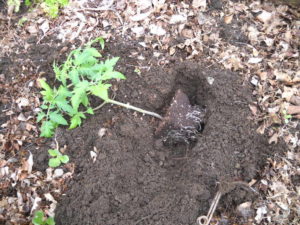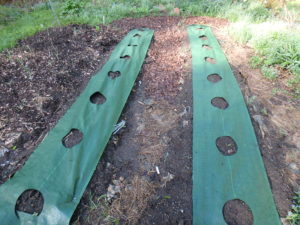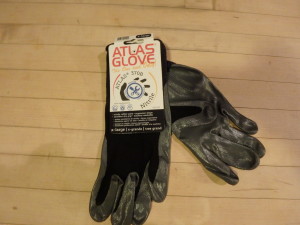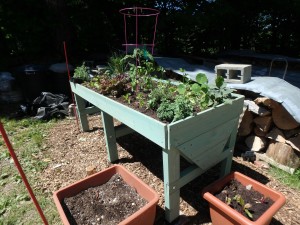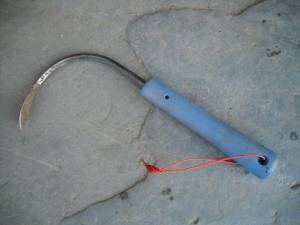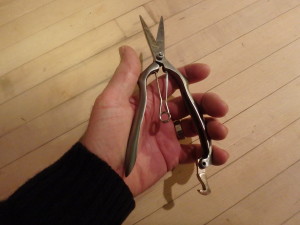It’s (Almost) Time to Plant Tomatoes
Maybe you’ve already planted your tomatoes. I have not. I’m waiting until June 10. By then, even in my cold Zone 4 garden, I know there will be no more frost and the ground will be above 60 degrees. And the stars, moon and planets will be aligned from June 10 to 12 to promote success for fruits, one of the 4 categories listed in the Stella Natura calendar, a biodynamic guide that I follow (www.stellanatura.com).
I start my seedlings indoors in April, and I’m in no rush to put my babies outside in the cold, rainy world that I’ve been seeing in May. And even if you have planted yours, I bet mine will catch up with yours. Tomatoes hate cold feet and a few days of chilly rain will make them cranky – and slow their growth.
Before my tomatoes and other plants get in the garden they get “hardened off.” If you are new to gardening, that just means I introduce them to the sun and wind over a period of time. An hour at first, or a morning on a north-facing deck. Later 4 hours of afternoon sun, and finally, if the temperature will stay up above 50 all night, they have a sleep over outside, but out of the wind. All this just means when they go in the ground, they will not be shocked.
Do you buy your seedlings? Ask at the garden center if the plants you buy have been hardened off. Even Brussels sprouts can be damaged if they have never been hardened off and go right in the garden.
I want my tomatoes to have lots of vigorous roots. To help ensure this I pinch off most leaves on the stem, leaving just those on the very top – sort of like a cartoon palm tree. Then I bury that stem and it develops lots of extra roots. Sometimes I just plant the root ball and stem down deep. Other times I plant the tomatoes sideways: I make a space for the root ball, and a little trench for the stem. I cover all that, and turn up the stem at the top so the few remaining leaves are barely above the soil line.
Leggy broccoli can be planted deeply, too, to help it stay erect, and to develop more roots. Legginess is common for seedlings started indoors that have been a little light-starved, and I think all can be planted deeply, but only have done this with tomatoes and broccoli.
What else gets extra care and a late planting date? Eggplants, peppers, cucumbers, squash of all types and basil. They all like hot climates, and come from them. I did plant seeds in May including peas, spinach, carrots, beets, parsnips, cabbage and lettuce. Those are all doing fine. Actually peas went in a bit late and are not up yet for me at the time of writing.
Peas can be very slow to germinate, and can even rot in the ground if we get a lot of cold rain. I plant most everything in raised beds, in part, to get the soil to warm up early and to dry out better. My garden is near a stream and we have a high water table, so raised beds help. I just mound up the soil from walkways and add compost to get nice raised beds.
Peas and beans of all types can benefit by being inoculated with a bacterium powder that is sold in garden centers and at my feed–n-grain store. Peas and beans are legumes, a group of vegetables with nodules in their roots. If these contain rhizobium bacteria, they take nitrogen from the air and “fix” it so that it stays in a form useable by plants. Free fertilizer, if you will.
Contrary to “rural legend”, the nitrogen fixed by peas and beans does not improve the soil very much. I always thought the rhizobium bacteria were pumping nitrogen into the soil. In fact, most of the production is used by the plants themselves.
The nodules that contain the bacteria are generally pink or reddish when producing well, and can be as big as a pea. When you pull a pea or bean plant, look at the roots. If you do not see lumps of nodules, be sure to introduce the bacteria next year (it may or may not be present in your soil naturally).
A few words about mulching: do not mulch your plants right away. Wait until the soil is very warm – 60 degrees or more – before mulching. Yes, the mulch will keep down weeds and hold in moisture, but it will also prevent the sun from warming the root zone.
I know gardeners that like to put down black plastic to kill weeds and add heat to the soil. I have used it –particularly for growing watermelons and pumpkins – but don’t like it. Most plastic lasts just one year and then has to go to the landfill. It’s not a sustainable practice.
I do like using woven landscape fabric, however. A Vermont company, GardenMats, produces rolls of fabric with pre-cut holes spaced for specific crops. These mats keep down weeds but let air and water pass through. The rolls are 4 feet wide, but I slice mine down the middle as my raised beds are only about 30 inches wide. I put leaves or mulch hay around the edges and in my walkways.
New England weather is never predictable, so I tend to plant later than many gardeners. Usually I am glad I did.
Read Henry’s blog at dailyUV.com.
Holiday Gifts for the Gardener
It’s that time of the year again: time to figure out good gifts for Uncle Albert and your sister Sadie. If they’re gardeners, gifts are easy to pick. There are plenty of items that cost from $5 to $300, and generally, one size fits all. Let’s look at some things I have used and like.
After giving a talk at the Milford, NH Garden Club recently, I bought some gardening gloves that were being sold as a fund raiser. These cost me just $5, and have already earned their keep. These are nitrile gloves made by the Atlas Glove Company. They have a waterproof palm and a stretchy, breathable fabric back. I have big hands, and the x-large size was perfect. Mine are black with silver palms, but the smaller sizes come in a variety of colors.
I don’t generally wear gloves when gardening, as most are too thick – and I like the feel of the soil – but in cold weather I do wear them. These are thin enough that I can go easily in my pants pocket and pull out my pocket knife, or feel a tender weed. The nitrile glove is the Atlas 370B series. I’ve also used a thicker Atlas glove with a natural rubber palm, the 300 series. These are both available at most gardening centers.
Does your loved one start plants by seed? Gift cards at garden centers or seed companies are nice. I get my seeds from several places: the Hudson Valley Seed Library, Johnny’s Selected Seeds, High Mowing Seeds, Renees Garden and a young company in New York State, Fruition Seeds. All have wonderful selections.
One of my favorite additions to my garden this year was a “VegTrug” from Gardener’s Supply Co. (www.gardeners.com, Item#8586918). This is a stained cedar planting box on legs, about 6 feet long and 32 inches wide that retails for $279, with free shipping. It is V-shaped in cross section with the deepest portion 16 inches deep – deep enough for potatoes or tomatoes. It stands 32 inches tall, so no bending is needed to weed or to pick.
In my VegTrug I grew one patio tomato and pretty much every kind of herb: basil, dill, marjoram, thyme, sage, purple sage, chives, oregano and parsley. I even had a nasturtium cascading over one end.
One reason I loved my VegTrug was the convenience: it allowed me to have herbs near the house in a spot not otherwise suitable for growing. And the plants grew well, although in the heat of the summer they dried out more quickly than my garden near the stream, so I watered pretty much every sunny day. It uses 380 liters of soil mix, so I made my own, a 50-50 mix of peat moss and compost. The bottom is slotted for drainage, but it comes with a woven liner to prevent soil from washing away.
Every gardener needs a good weeding tool, and every year I recommend the CobraHead Weeder, because I believe it is the best weeding tool available. This tool has a single tine that is curved like the shape of a rising Cobra. I use it to tease out grass roots, to get under large weeds (so I can loosen the soil below them and pull from both top and bottom of the weed at the same time), and for preparing soil to plant. Now it seems a part of my right hand (though it is right-left neutral). At under $25 locally or from the manufacturer (a family business found at www.CobraHead.com), this tool is tough, strong, and made in the USA.
Every year I try to learn more about growing healthy plants. This year I paid $50 to join the Bionutrient Food Association (http://bionutrient.org/), and would like to suggest giving a membership as a nice present. One of the goals of the non-profit is to educate members about how to grow food that is nutrient-rich.
Much commercial agriculture depends on adding just 3 minerals to the soil (nitrogen, phosphorus and potassium) and basically ignoring the other nutrients that plants – and humans – need to be healthy. Growing vegetables year after year removes micronutrients from the soil that need to be replaced. The BFA offers information and workshops that I believe will help me to grow better food and stay healthy.
Weeds are the bane of many gardeners. One way to minimize their presence is to weed daily, mulch, or to put down weed mats. A Vermont company, Garden Mats (https://gardenmats.com) produces heavy-duty woven mats with pre-cut holes in a variety of patterns for different vegetables. I’ve used them – and re-used them. They keep down weeds, hold in some moisture, but also breathe and let rain penetrate. They are 4 feet wide and come in lengths of 6, 12 and 18-feet for a cost of $11 to $31. They are definitely a labor-saver, and they claim the mats increase yields 10% to 20%, too. I like them, and also the fact that it is a small, family-owned business.
The last item for this year’s list is a lovely pair of stainless-steel garden shears for cutting flowers, herbs, and for use in the kitchen. Made in England, these shears are elegant as well as sturdy, and are said to be designed for small hands. Sold by Gardeners Supply (Item#8593404), they retail for $60 and come in a handsome gift box.
Santa, if you’re listening, I have everything I need. So you can just volunteer to come work in my garden next summer. I know it’s the off-season for you, and we both need to lose some weight, anyhow. We can pull weeds and eat cukes.
Read Henry’s blog at https://dailyuv.com/gardeningg



